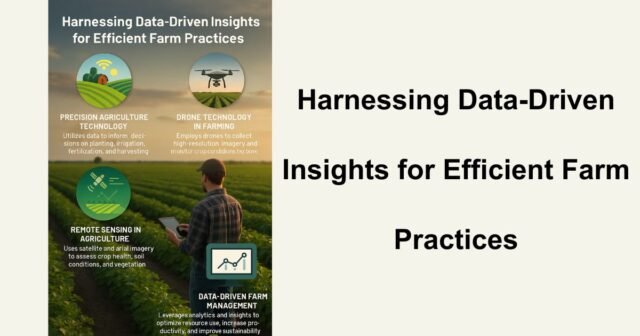In the evolving landscape of modern agriculture, technology is transforming traditional farming into a sophisticated, data-powered enterprise. The integration of tools like Precision Agriculture Technology allows farmers to make informed decisions based on real-time data, leading to higher yields, lower costs, and sustainable operations. As global demand for food rises and arable land shrinks, harnessing data-driven insights is no longer a luxury—it’s a necessity.
The Shift Toward Smart Farming
Farming is no longer just about intuition and experience. Today, data plays a crucial role in determining what crops to plant, when to irrigate, and how to optimize resources. Data collected from sensors, satellites, weather stations, and farming equipment feeds into intelligent software platforms that offer farmers actionable insights.
This shift towards “smart farming” empowers growers with the tools they need to improve efficiency, profitability, and environmental impact. Agritech software solutions are central to this transformation, offering capabilities that enable real-time monitoring, forecasting, and performance tracking at scale.
Role of Data in Modern Agriculture
Data-driven farming begins with collection—gathering relevant information from various sources:
- Soil sensors capture moisture, pH, and nutrient levels.
- Weather data forecasts conditions that affect crop health and harvesting times.
- Machinery sensors track performance and usage patterns.
- Yield monitors record harvest data to evaluate productivity.
Once collected, this data is processed by advanced analytics platforms. These platforms help farmers visualize trends, assess risks, and determine optimal actions. For example, data might reveal that a particular section of a field is underperforming due to soil deficiencies, prompting targeted fertilization rather than uniform application.
Enhancing Crop Management
One of the most impactful applications of data in agriculture is in crop management. From planting to harvesting, data insights enable precise decisions at every stage.
Planting: Data helps in selecting the best planting dates, seed varieties, and planting density based on soil conditions and historical yield data.
Growth Monitoring: Ongoing monitoring ensures timely interventions such as irrigation, fertilization, or pest control. This reduces input waste and boosts crop health.
Harvest Timing: Predictive analytics help determine the ideal harvest window to maximize yield and quality, improving profitability and reducing post-harvest losses.
Resource Optimization
Farming efficiency isn’t only about improving yields—it’s also about minimizing waste. Data analytics helps optimize the use of critical resources such as water, fertilizers, and pesticides.
- Irrigation Efficiency: Smart irrigation systems use soil moisture data and weather forecasts to water crops only when needed, reducing water waste.
- Fertilizer Management: Data enables variable rate application, ensuring nutrients are applied precisely where they’re needed.
- Pest and Disease Control: Early detection through data analytics can lead to timely interventions, reducing reliance on blanket pesticide applications.
These optimizations not only reduce operational costs but also contribute to environmental sustainability.
Remote Sensing: A Game Changer in Field Monitoring
One of the most transformative tools in modern agriculture is Remote Sensing in Agriculture. Satellite imagery, aerial photography, and sensor-based observations enable farmers to monitor vast areas of farmland without setting foot in the field.
Remote sensing provides insights into:
- Crop health and stress indicators
- Soil moisture levels
- Plant density and biomass
- Pest and disease outbreaks
By leveraging this information, farmers can detect problems early, localize their responses, and avoid large-scale losses.
Drone Technology: Taking Precision to New Heights
Another innovation reshaping the agricultural landscape is Drone Technology in Farming. Drones equipped with multispectral cameras and thermal imaging sensors can fly over fields to gather high-resolution data in real time.
Drones provide several advantages:
- High-Speed Monitoring: Cover large areas in minutes, compared to hours or days on foot.
- Accurate Crop Mapping: Generate detailed field maps that help pinpoint issues like nutrient deficiency or weed infestations.
- Efficient Spraying: Some drones are equipped to perform spot spraying, reducing chemical usage and environmental impact.
With drones, farmers gain a bird’s-eye view of their operations, allowing for highly localized and responsive decision-making.
Predictive Analytics and AI in Farming
Data is only valuable if it leads to action. Predictive analytics and AI algorithms transform raw data into future-ready insights. Machine learning models can forecast crop yields, predict pest outbreaks, and recommend the best times for planting and harvesting.
AI-powered platforms learn from historical data and current conditions to offer personalized suggestions for individual farms. This level of precision ensures that decisions are not just based on general trends, but on the unique characteristics of each farm.
Integration with Farm Management Systems
Modern agritech software doesn’t operate in silos. Today’s leading platforms integrate data from multiple sources—field sensors, drones, satellite imagery, and farm machinery—into centralized farm management systems (FMS). These platforms provide a comprehensive dashboard that visualizes key metrics and offers actionable insights.
Features often include:
- Field mapping and zone management
- Input tracking (seeds, fertilizer, water, etc.)
- Budgeting and cost analysis
- Historical data review and comparison
An integrated FMS allows for seamless planning, tracking, and optimizing of all farm operations in one place.
Empowering Sustainable Agriculture
Sustainability is at the core of modern agriculture. Data-driven farming supports this goal by reducing overuse of inputs, enhancing soil health, and promoting biodiversity. As regulatory pressure increases and consumer demand for sustainable food grows, farmers who adopt data-centric practices will be better positioned to meet both environmental and market expectations.
Conclusion
The future of farming lies in embracing data as a strategic asset. By adopting technologies like Precision Agriculture Technology, Remote Sensing in Agriculture, and Drone Technology in Farming, growers can unlock new levels of efficiency, productivity, and sustainability. As agritech software continues to evolve, it will play a pivotal role in transforming data into decisions—and decisions into results. For farmers ready to thrive in the digital age, now is the time to invest in data-driven solutions and sow the seeds of a smarter future.







